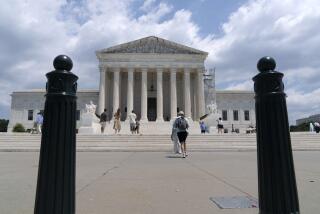1st Amendment’s Breaking Point
- Share via
Where lies the crucially important distinction between forceful free speech and behavior that threatens or incites to violence? A federal jury in Oregon did not have to answer that question, but it did decide Tuesday that an Internet Web site had gone far beyond the protections of 1st Amendment free speech rights. We are inclined to agree that’s what happened in this case.
The anti-abortion Web page attempted to graphically and philosophically equate doctors who perform abortions with Nazi war criminals. But it was the method employed that the jury deemed a threat: wanted posters; lists of doctors and their relatives by name, sometimes with home and work addresses and routes to work.
Most chilling perhaps was a master list of physicians around the country who perform abortions. The names of doctors who have been murdered in anti-abortion violence had been crossed out with a black line. Those wounded were printed in gray.
The site contains a number of disclaimers: “This site has nothing to do with violence being carried out against physicians,” one said. But the jury was not swayed. It ordered two anti-abortion groups and several individuals in the case to pay $107.9 million in fines.
Critics of the decision argue that it constitutes an abrogation of free speech, one that can be used against any group with controversial views. But free speech has limits--those against slander and libel, against someone falsely yelling “Fire!” in a crowded theater, against incitement to riot and others. The Web page in this case was still functioning Wednesday and has not been ordered to shut down.
The Times has supported rights that many might regard as leading to annoying acts: the right of paparazzi to get their photographs; the right of a merchant to display a portrait of Ho Chi Minh in a stridently anti-Communist community; the right of Oprah to disparage hamburger meat. We have also argued against laws to protect children against online smut because they would stifle much in the way of legitimate adult debate too.
But the defendants in this case, in the eyes of a jury, went well beyond the reasonable. The jury decision should be seen not as a blueprint for stifling the free expression of ideas but rather as a warning to those who would try to wrap threats in the cloth of the 1st Amendment.
More to Read
Get the L.A. Times Politics newsletter
Deeply reported insights into legislation, politics and policy from Sacramento, Washington and beyond. In your inbox twice per week.
You may occasionally receive promotional content from the Los Angeles Times.










